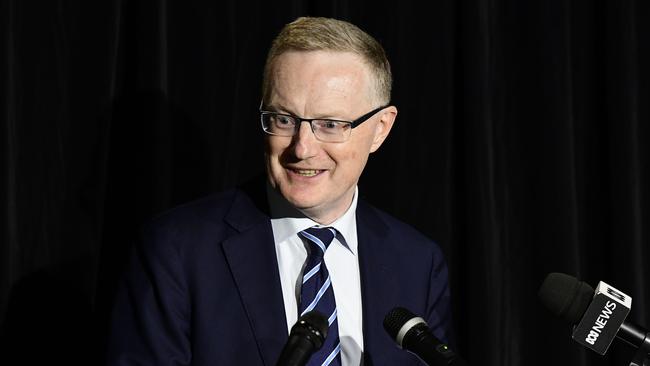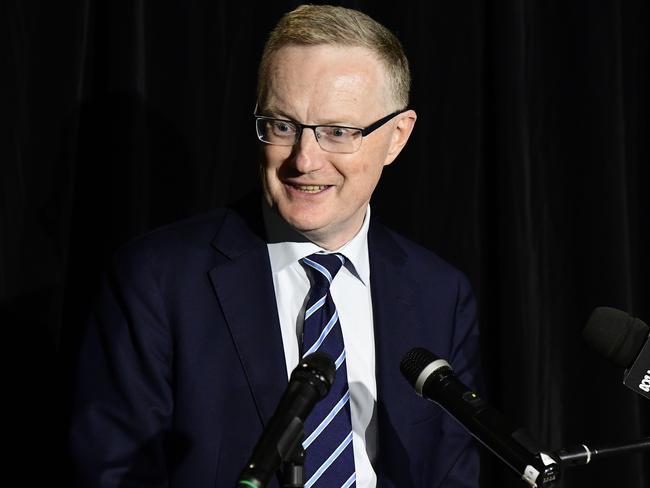Terry McCrann: A second rate cut is on the way, although precisely when is not clear
The latest jobs figures have ensured a second cut to the cash rate by the Reserve Bank is now a certainty, but when will RBA governor Philip Lowe cut and will he contemplate a third cut, asks Terry McCrann.

Terry McCrann
Don't miss out on the headlines from Terry McCrann. Followed categories will be added to My News.
Now that he’s finally done it once, will Reserve Bank governor Philip Lowe get the taste for it and cut the RBA’s official interest rate a second time?
The latest jobs and jobless numbers delivered an unambiguous answer: Yes.
And then we’d be on to another round of “watch the banks”.
Two other important things are, though, much, much less certain. When will he cut and whether he would contemplate a third cut after that.
Actually, he — and RBA management and board — would contemplate a third cut, but they might conclude that taking the official rate below 1 per cent would be largely ineffective and even counter-productive.
Now, it’s not that the May jobs and jobless numbers were particularly bad. They were actually pretty good.
Jobs jumped by 42,300, although almost all of them were part-time ones.
The jobless rate didn’t go down, but stayed unchanged at 5.2 per cent because more people came into the workforce looking for a job — usually considered a good thing and a sign of an economy doing at least reasonably well.
But just when we need maximum clarity on data like this — dodgy as it all tends to be anyway — wouldn’t you know it, the politicians muddied the waters by having an election in the middle of May.
No, it wasn’t the possible impact of fear and loathing at a potential Labor win on jobs creation — or grief and mourning and retreat at the Labor loss — that threw the figures off course.
But something much more prosaic — all the temporary workers hired to actually do the election. It’s unclear how much that boosted the jobs numbers.
What we can say is that taking that unknown impact out would have resulted in slightly — if indeterminedly — worse numbers.

And on that basis, I would repeat what I wrote after the inflation data in April: They open the door to a rate cut, but Lowe & Co are unlikely — at this stage — to walk through it at the next meeting in early July.
The “at this stage” is necessary because these days an awful — and that word is used very deliberately — lot can happen in the space of a couple of weeks.
If something awful did happen, he’d cut.
The one thing the jobs numbers were not, was the sort of sharp deterioration that would have made a further rate cut not only mandatory but urgent.
As Lowe and one of his key assistant governors, Luci Ellis, on Wednesday have night made publicly clear, the RBA will take further action to boost the economy unless the jobless rate actually fell, and fell significantly below 5 per cent.
The kick-up in the rate from 5 to 5.2 per cent a month ago triggered the first cut, as I told you on election eve it would.
The fact it then stayed at 5.2 per cent (with a slight upward bias because of that election issue) triggers a second cut. But, to repeat, not urgently.
The most likely to all-but-certain time now is at the August meeting. That will come after the next lot of jobs and jobless data, which apart from anything will wash out the election issue.
It will also coincide with the RBA’s regular quarterly economic forecasts.
They are going to have to downgrade at least its growth forecast for this calendar year. Assuming it hadn’t cut in July, it would be bizarre if the RBA did that and didn’t deliver a cut.
By August the RBA — and the rest of us — will also have got to see whether the Senate had delivered the government’s promised July “cash splash” tax cuts.
As I’ve argued we need both the tax cuts and two rate cuts.
But if the banks — illegitimately — found the first rate cut difficult to fully pass on to borrowers, they are legitimately going to find the next one even more so.
But they’ll “pass it on” to depositors — provided they still can. With so many deposits now getting zero or all but zero rates, the banks face a real squeeze.
This is why it might be a good idea all round for the RBA to stop at 1 per cent — that’s another official cut — and then embark, if it thinks further stimulus is needed, on more direct, so-called “quantitative easing”.
Why keep forcing deposit rates lower and lower until they hit zero; but with limited effect on bank actual lending rates?
Literally, pause for thought.
LABOR MUST DO ITS DUTY
Labor must do its duty to Australia and commit to passing the government’s tax cuts immediately and in full.
Apart from the basic fact the government has the most clear-cut mandate you could ever ask for, the tax cuts were explicitly spelt out in the Budget and sat at the very heart of the government’s election campaign.
They are now clearly needed to keep the economy ticking over and putting people into jobs.
It’s not me saying this — but RBA governor Philip Lowe. Indeed, the tax cuts are just the most urgent and only the start.
More stimulus will probably become necessary.
And that’s when Labor can legitimately start to argue and oppose — over things the government might want to do but it did not include in either the Budget or the election campaign.
It is not just ridiculous but an abdication of its basic responsibility as the major alternative party of government for Labor to be prepared to leave the economic governance of this country hostage to the Senate cross-beach and the Green loonies.



